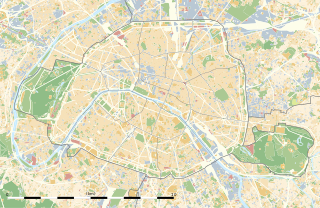
The 3rd arrondissement of Paris is one of the 20 arrondissements of the capital city of France. In spoken French, this arrondissement is colloquially referred to as troisième.

The 9th arrondissement of Paris is one of the 20 arrondissements of the capital city of France.

The Amphithéâtre Anglais in Paris, also known as the Amphithéâtre d'Astley, and later as the Cirque Olympique or Cirque Franconi, was opened in 1782 by Philip Astley, the English inventor of the modern circus ring, as the first purpose-built circus in France.

Le Grand Rex is a cinema and concert venue in Paris, France. It is noted for its sumptuous decoration and its outsized main auditorium, which is the largest cinema theatre in Europe.

The Café des 2 Moulins is a café in the Montmartre area of Paris, located at the junction of Rue Lepic and Rue Cauchois. It takes its name from the two nearby historical windmills, Moulin Rouge and Moulin de la Galette. The interior consists of a bar area and multiple small tables.

The Théâtre du Marais has been the name of several theatres and theatrical troupes in Paris, France. The original and most famous theatre of the name operated in the 17th century. The name was briefly revived for a revolutionary theatre in 1791, and revived again in 1976. The present-day Théâtre du Marais operates at 37, rue Volta in the 3rd arrondissement of Paris.

Rue du Bac is a street in Paris situated in the 7th arrondissement. The street, which is 1150 m long, begins at the junction of the quais Voltaire and Anatole-France and ends at the rue de Sèvres. The street used to be in the fashionable Faubourg Saint-Germain.

The Bibliothèque-Musée de l'Opéra National de Paris is a library and museum of the Paris Opera and is located in the 9th arrondissement at 8 rue Scribe, Paris, France. It is no longer managed by the Opera, but instead is part of the Music Department of the National Library of France. The Paris Opera Library-Museum is open daily; an admission fee is charged.

The lycée Buffon is a secondary school in the XVe arrondissement of Paris, bordered by boulevard Pasteur, the rue de Vaugirard and the rue de Staël. Its nearest métro station is Pasteur. It is named for Georges-Louis Leclerc, comte de Buffon. Jean-Claude Durand is its current proviseur.

Hôpital Saint-Louis is a hospital in Paris, France. It was built in 1611 by architect Claude Vellefaux at the request of Henry IV of France. It is part of the Assistance publique - Hôpitaux de Paris hospital system, and it is located at 1 avenue Claude-Vellefaux, in the 10th arrondissement near the metro station: Goncourt. Its address is 1 avenue Claude-Vellefaux, just north of rue Bichat.

The Palais Berlitz is an office building built in Paris in the 1930s on a block formed by the Boulevard des Italiens, the rue Louis-le-Grand, the Rue de la Michodière and the rue du Hanovre.

The Crédit Lyonnais headquarters is a Haussmannian style building in the 2nd arrondissement of Paris. It is located on the block formed by the Boulevard des Italiens, the rue de Gramont, the rue du Quatre-Septembre and the rue de Choiseul.

The Rue des Marronniers is a street located in the Bellecour quarter, in the 2nd arrondissement of Lyon. It is a small paved pedestrian street famous for its many bouchons. It is served by the metro station Bellecour and many buses. The street belongs to a zone classified as a World Heritage Site by UNESCO.

The École de Chirurgie is a historic building located at 10–12 rue de l'École de Médecine in the 6th arrondissement of Paris. Today it is the headquarters of the Paris Descartes University.

Le Divan du Monde is a converted theatre, now functioning as a concert space, located at 75 rue des Martyrs, in the 18th arrondissement, in the Pigalle neighborhood of Paris.

La Gaîté Lyrique is a digital arts and modern music centre opened by the City of Paris in December 2010, located at 3-5 rue Papin in the 3rd arrondissement.

Passage Choiseul is one of the covered passages of Paris, France located in the 2nd arrondissement. It is the continuation of Rue de Choiseul.

The Salle de la Bouteille or Salle du Jeu de Paume de la Bouteille, later known as the Hôtel [de] Guénégaud or Guénégaud Theatre, was a 1671 theatre located in Paris, France, between the rue de Seine and the rue des Fossés de Nesle across from the rue Guénégaud. It was the first home of the Paris Opera and in 1680 became the first theatre of the Comédie-Française.

The Arlequin is a cinema in Paris, noted for its spacious modernist main theatre and its former role as a showcase of Soviet film.
Le Manoir de Paris is a walk-through haunted house. It is one of the former ceramic workshops of Choisy-le-Roi, in the 10th district of Paris, France.























